George Dyson (1850-1932)
George Dyson was part of the new system of education in which the state shared responsibility with the Churches following the 1870 Education Act. Son of a skilled railway employee, he had received a professional training and was willing to move about the country to secure professional advancement.
He came to Tewkesbury as Head Master of a recently amalgamated Holy Trinity Infant and Junior school and he remained 26 years, during which period the state took further control of education after the 1902 Education Act. George and Emma (who had been herself a Head Teacher) both taught at the school and raised a family of six children. At the beginning of the Great War, he moved to be Head Teacher at a rural school near Newent. One of his daughters married Granville Langston.
The Dyson/Langston family papers were inherited by the late G.J. (Jim) Langston, George Dyson’s grandson. Jim and the author’s father, Frank Roche, were fellow R.A.F. prisoners of war during the Second World War. They were reunited in 1953 when Frank Roche joined the staff of Newent School, where Jim Langston was already a master. The Dyson/Langston family had a tradition of retaining all family documents – were it not for this, the biography of George Dyson would never have been written. Regrettably, Jim Langston died in 2006 before the biography was completed.
Adrienne Roche, the daughter of Jim’s friend, became a member of T.H.S. when researching the Dyson family; she has been a teacher living in London for over 35 years.
Empire Day, after 1901, took place on 24 May, Queen Victoria’s birthday. It was designed to reinforce the interest of the nation in our Empire which was then at its height. In 1958, with the disbandment of Empire, it was renamed Commonwealth Day. In my life-time, it has not been celebrated as in 1908. (Editor)
Life before Tewkesbury
to Expand
George Dyson was born in 1855 near Rotherham, Yorkshire, the second son of George Dyson (born 1821 Darton, Yorks.) and Elizabeth (née Baxter, formerly Telfer, known as Bessie) who was born 1813 in Lockerbie, Scotland. He had an elder brother Dick and a half brother John (‘Jack’ born 1846 in Lockerbie), Elizabeth’s son from her first marriage.
His father, George Dyson senior, was an engine driver or ‘engineer’ who was employed by one or another of the many 19th century British railway companies. Not surprisingly the family moved frequently: elder brother Dick was born in Bicester and George was born in 1855, after the family moved to Rotherham, Yorkshire. The family then moved to Bedfordshire in 1858.
However, George Dyson’s father does not appear with his family on any census return from 1851. In 1863 he bought several houses in Kimberworth, near Rotherham, with an inheritance and, into one of these, moved Bessie and their sons.
By the late 1860s, George senior had settled, alone, in Dorset.
However, letters from George senior to the young George indicate that he was a loving, caring father despite his absence. In May 1869, young George went to stay with his father for a week in Sherborne, sitting for photographs in a Salisbury studio. The boy kept a small diary in which he recorded details of his two day ‘Whitsuntide tour’ of the area, including a visit to the training ship Boscawen off Portland, to Corfe Castle and to Wareham. Perhaps this time together included discussion of young George’s future – if he were to continue his education, it would have to be paid for. He decided to return to school for he may have decided already that his future lay in teaching.
In February 1871, the young George took over his brother Dick’s task of collecting rent from their father’s Kimberworth houses. He continued to use his diary to record income and expenses which included “Boots for Mother,” new collars, garden maintenance, the occasional household furnishings, his ‘pass’ (probably for rail travel), his school books, his father’s Lodge subscriptions, plus several Biblical and musical references, his lesson timetable, and his father’s various Dorset addresses. He took fourteen shillings every week for “Living” and carried the balance over to the following week.
Details of the years 1871-1873 are vague; George remained at school but precisely when he became a pupil-teacher is not known. Elementary school children who became pupil-teachers received three years’ concurrent training and education and were prepared for the Queen’s Scholarship Examination at 18 years of age. Originally both training and education took place in their elementary school under the supervision of the headmaster or mistress. After the 1870 Elementary Education Act,[1] however, instruction was given at pupil-teacher centres run by the local school board while continuing teaching practice at their elementary school. Successful Queen’s scholars then were able to attend teacher-training colleges for two or three years. These were residential colleges, run by voluntary societies – mostly Church of England – with some government subsidy.
However, George seems to have begun his formal training at the age of eighteen in 1873 at one of St. Mary’s schools, Sheffield. There was a ‘family rumour’, a generation later, that he had attended the public school Sherborne and that his eldest daughter had concealed the fact from the rest of her siblings – to what purpose is a mystery – but there is no evidence of this. In any case, any pupil leaving public school for a teaching career would most likely have gone straight to college or university rather than become a pupil-teacher.
From all accounts George’s four and a half year teaching apprenticeship was most successful. Testimonials written by the headmaster and several of the diocese’s clergymen, describe a young man of admirable ability and integrity. Nevertheless, George did not attend training college (although he did some years later) and further testimonials and school inspection dates indicate that he was accepted immediately as an assistant master in early 1878 at the very school at which he had trained.
Fifteen months later in 1879, he became assistant master (‘certificated’) at Croft’s School Boys’ Department and, in 1880, he became the Headmaster of St. Peter’s National and Infants Schools, Sheffield, with an annual salary of £71.1s.11d.[2] In every testimonial and report, all aspects of George Dyson’s character and teaching ability are described as “exemplary”. By now, George had met his future wife, Emma Banner (born 1855 in Cheltenham) They may have met when George was teaching at St Mary’s Schools when Emma was Head Teacher of a school in the same parish or later on, when fellow Head Teachers. The 1881 census for Sheffield records Emma as a “Head Teacher with three assistants and two apprentices,” boarding in Eyre Street, while George is an unmarried school teacher boarding at Cemetery Road, Eccleshall, a suburb of Sheffield.
Church with the Head Teacher’s
house to its right and the
Junior School across Trinity Walk.Click Image
to Expand
Emma Banner was the eldest child of Benjamin Banner, a boot-maker. She had been both pupil and pupil-teacher at Holy Trinity School, Cheltenham. According to The Schoolmaster of February 1875, Emma Banner came fifth out of the year’s 1,185 female entrants in the national final examinations. She subsequently studied at the Home and Colonial College, London, from 1875 to 1877.
They were married at Holy Trinity Parish Church, Cheltenham, in September 1882. She and George returned to Sheffield where their first child Emma Banner Dyson was born in July 1883. George, meanwhile, continued to receive excellent school inspection reports and his salary increased to £151.17s.5d.[3] An H.M.I. wrote: “Mr. Dyson has done good work with a poor class of children, and deserves great credit for what he has achieved.” [4]
In the summer of 1886, when Emma was pregnant with her second child, George resigned his post at St. Peter’s school – perhaps with relief for it transpired later that his experience there had not been entirely happy – having been granted a place at Cheltenham’s teacher training college for the forthcoming year.
A second daughter, Mary Olivia (“Olive”), was born in Sheffield in October 1886, and soon afterwards George, Emma, and their daughter moved to Cheltenham. No details survive of George’s college days other than letters written to him much later (1894) by various ‘Old Chelts’, recalling friendships and happy days at college, offering warm wishes and promising to support a Teachers’ Association candidate for whom George was currently canvassing.
In August 1887, he left Sheffield with an open letter for George, “bearing very strong testimony in favour of the character and qualifications of Mr. George Dyson” and subsequently, at the beginning of 1888, George Dyson became Headmaster of Holy Trinity Schools, Tewkesbury.
A former (20th century) pupil wrote:
“Holy Trinity Infants’ School was actually next door to 41 Oldbury Road…You reached the school from the Oldbury along a narrow alley, Trinity Walk, which was paved with blue-black bricks and ran between two high red brick walls…30 yards further down Trinity Walk was the Holy Trinity Junior School…The school was built in late Victorian times of red brick with tall steeply pointed grey-slate roofs, slightly church-like, and there was a large tarmac-ed playground, but no playing field. Inside, the classrooms were high ceilinged and large…There were wooden desks in rows and the teacher…sat at the front. The classrooms were heated by a ‘Tortoise’ coke-burning cast-iron stove…”
Life in Tewkesbury
skating Tewkesbury early 1890s (Roche)Click Image
to Expand
Holy Trinity church had been built in 1837 for the working people of the Oldbury and the then ‘National School’,[5] initially for infants, was built in 1843. The later addition of the Junior school enabled an intake of 200 boys and 150 girls which would have been as George Dyson found it in 1888.
North of Trinity Walk was the head teacher’s home (now the Masonic Hall) whilst south was the school (now used by the Sea Cadets). Trinity Street is a little way to the north being a narrow road linking the High Street with the church.
In early January 1888, probably before the start of the spring term, George Dyson’s father wrote to his son:
“…and I am pleased to heare the Parsone is a pleasant Person. I hope you will get on well together Mind and keep thyself up to the mark in thy Work and be very kind to the Schollers thow will find them a different Class from the Sheffield Children and I expect the School is in more healthy situation if S.B. (?) Visiters come and invite tell at once thow are a totel (teetotall) and do not visit theas places except on speacel business but be kind and famealer to all………trusting you are in good health and the situation will prove more suitable to you than Sheffield it was a very unpleasant situation that Sheffield School, let us trust the change will be for the best…I am…Yours truly and affaconate Father Geo Dyson” [6]
The ‘parsone’ was the Reverend Edward Hyde F. Cosens M.A. (Oxon), in his own words, “Incumbent of Holy Trinity Church and, correspondingly Manager of the Holy Trinity Tewkesbury National and Infant Schools.” Later that year, in the summer of 1888, George and Emma’s first son, also named George, was born. In March 1891, a fourth child, Lily, was born to Emma and a nurse, Hannah Lewis, was employed to help.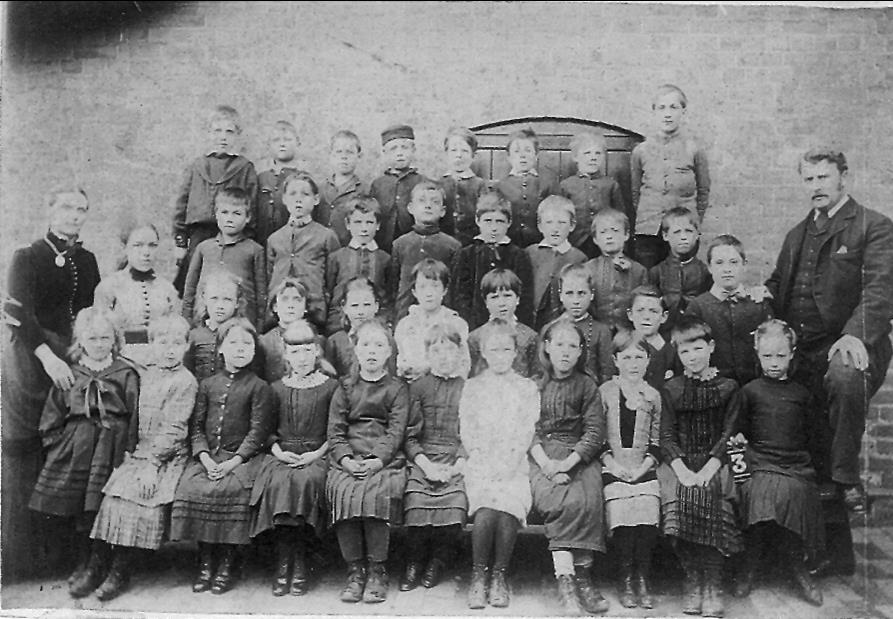
Standard 3/5 with George and Emma Dyson in the 1890s (Roche)
By the end of March 1891 – after only three years – George had thoughts of leaving Holy Trinity Schools. Rev. Cosens wrote an excellent testimonial to the Council of the Feltham Industrial School, Surrey, supporting George’s application for the post of school superintendent. This post was not for the faint-hearted and would have been very challenging; industrial schools had a very mixed pupil intake and a poor reputation. Although many pupils were from National or Charity schools, a large number of pupils had had no previous education; some were from the so-called ‘Ragged Schools’ with a number coming from Reformatory or Prison schools. However, as it happened, George was to remain at Holy Trinity.
In early December 1892, an outbreak of Scarlet Fever, then – as now – a highly contagious and life-threatening illness, was reported to the authorities by George Dyson and William Allard, a surgeon of the High Street.Francis, Emma and George’s fifth child, was born at the end of June 1893. Just two days later, on the 1st July, a case against George Dyson for assault upon one Alfred King was dismissed.[8]
Alfred King was a brewer’s labourer, aged 24, probably the son of local waterman Edward King. Alfred King lived in Wilkes Alley, with his wife Louisa (née Pratt), 28, a shirt factory machinist and their three children: Rose 7, Alfred 6 and Annie 3 and Louisa’s younger sister Edith. The reason for the allegation is unknown, but it is likely that Alfred King senior had taken offence at something said or done concerning one or both of the older King children and had taken his revenge with an accusation of assault.
Since George Dyson appeared to have inherited his father’s piety and generosity of spirit, it seems highly unlikely that he would have resorted to violence. In later years, in letters to and from members of his family, he comes across as a kindly, bluff and humorous character. Indeed, some years ago an elderly Tewkesbury couple in conversation with James Langston, George’s grandson, recalled the late headmaster as having the nickname of ‘Daddy Dyson’, which supports the idea of a rather gentle man held in some affection by his pupils.
family in the 1890s (Roche)Click Image
to Expand
In 1893 when Emmie was a pupil, one term’s tuition fee was £1.10s. plus 15s. for music lessons.[10] She studied eight subjects; one of her reports states that she is “decidedly progressing”. She also attended local art classes, winning several prizes in 1893 and 1894. In early 1894, Emmie was examined by George Reeves, ‘Professor of Phrenology’ in Tewkesbury. His analysis indicated that Emmie was multi-talented and, although lacking a little in concentration and confidence, she had an excellent future, particularly in teaching. This proved an accurate analysis. In 1896, Mabel, George and Emma’s sixth and last child, was born.
Whilst much information exists of George Dyson’s family life, far less is known about his experience as headmaster. However, one particular incident, directly concerning the headmaster and school, was published in mid-November 1899. Then George took the Holy Trinity boys to the station to line up in honour of the Tewkesbury Reservists’ departure in the early days of the South African [Boer] war. Reportedly there was an “atmosphere of patriotic fever which seized all classes of the people”.
The headmaster also taught at the Evening Institute while Emma, his wife, also gave music lessons at home. In a letter, daughter Emmie wrote, “Christopher! 4 violins going in next room. A deaf man is lucky sometimes”. In addition, a Mr. Page was hired to teach chemistry five days a week to George’s elder son, George.
George Dyson took an interest in football and ice skating. He also loved the seaside and collected a large number of fossils. He was a keen hiker, walking long distances; on one occasion he met George Schilling, ‘The Famous American Athlete’ who was walking around the world and walked with him to Worcester, sending an autographed photograph to Emmie.
George Dyson and fassistant masters 1906-7 (Roche)Click Image
to Expand
The 1901 census records George and Emma Dyson as school master and mistress with their family at Holy Trinity School House. George’s daughter Emmie was by now a pupil-teacher in a local school, also attending Gloucester Pupil-Teachers’ Central Classes from 1899 until 1901.[11]
In August 1911 George and Emma’s eldest daughter Emmie and Granville Langston were married in Tewkesbury and moved to Gloucester.[12] George’s son, Francis, sailed to Australia in 1912, his occupation recorded as ‘labourer’. He was later to become a teacher. The following year, George’s eldest son George married Edith, a college friend of Emmie’s.
After twenty-five years at Holy Trinity Schools, George Dyson resigned in 1914 to become Head Master of Clifford’s Mesne School, near Newent, and lived at Hillcote. The reason for George’s departure is unknown: perhaps he felt that twenty-five years was long enough and the impending war may have further influenced his decision to move to a rural area. Family rumour was that he had quarrelled with the school governors. Coincidentally, this tallies with another family misconception – that George had been Headmaster of Tewkesbury Grammar School.
Life after Tewkesbury
in the 1920s (Roche)Click Image
to Expand
The only references of George Dyson’s years at Clifford’s Mesne, apart from family letters, are photographs of the house, the entries in Kelly’s Directories and the verbal testimony of Mrs. Freda Willis Turner (1910-2005) who was a pupil at the village school during his time and recalled that the headmaster would ‘give the slipper’ to those boys who misbehaved.
In 1919, George Dyson bought two adjacent houses for £500 in Culver Street, Newent, for his retirement. Family life had its inevitable ups and downs. His elder son George died aged 29 in early 1918, leaving a widow and baby son but he gained grandchildren.[13] However, younger son, Francis, sailed again for Melbourne and in 1924 daughter Lily had married a Lancashire cotton merchant and moved to Madras, India. In the autumn of 1925, his wife, Emma, died suddenly and unexpectedly aged 70.
In 1927 George moved to Barnwood in Gloucester where he died, aged 77, on 26 August 1932. He is buried alongside his wife, Emma, in Newent cemetery. His fossil collection was donated to Newent Grammar School.
Just before he died, there came an echo of his life in Tewkesbury in 1926, when his daughter Mabel visited. George reported that she
“went to a confirmation .. .. and had tea at High School and saw Mrs. Ricketts who invited her to tea etc etc. Saw Mrs. Driscoll – she wouldn’t like to be at Tewkesbury they’ve spoiled Trinity House and playground etc and upstairs no room now, same paper in rooms, new grates and new rugs in kitchen, no linoleum etc. Mrs Ricketts is transferred to Infant School which is our old school now. So who’s taking the girls at Abbey ( I ) don’t know – they’ve joined Abbey and Trinity now….” [14]
References
- Also known as Forster’s Education Act, it laid the basis of primary education with local elected School Boards allowed to raise a rate to run schools where there were not religious schools.
- £71.10p – worth about £3,250 today.
- £151.87p – worth about £7,250 today.
- Report of Her Majesty’s Inspector, March 1884
- Church of England elementary schools were known as ‘National Schools’.
- His own uncorrected writing.
- The date of this photograph could be the winter of 1890-1. See Derek Round, ‘The Great Freeze of 1890 – 91’, in Tewkesbury Historical Society Bulletin 16 (2007).
- Reported in the Tewkesbury Register, 01/07/1893, p1/6.
- Henrietta Emily Priestley, B.A., (née Rice) was the wife of Joseph Priestley, B.A., headmaster of Abbey House School. In 1882 this became Tewkesbury High School for Girls and closed as a Grammar School in 1972. From 1972 to 2006 it was the Abbey School. By c1910 the family changed the spelling to Priestley.
- £1.50 + 75 p – worth £81 and £42 respectively.
- Towards the end of 1906, George Dyson was summoned to his ailing father’s bedside, the latter having been taken seriously ill. George Dyson senior died of pneumonia in February 1907; his estate was to be divided between George and his brother Dick. Sadly, the following September, Dick died suddenly of a brain haemorrhage, some time before his late father’s estate was finalised.
- Tragically, a month later, George’s mother Bessie fell downstairs and died from concussion; she was 98 years old.
- A 2nd daughter Norah, was born to Emmie in 1920 and a son, Jim Langston, was born in 1921.
- In 1885, just before George Dyson arrived, it was a mixed school called Trinity National School. In 1903 the school came under the County Council's control and in 1919 amalgamated with the Abbey National School under the name Tewkesbury C. of E. School. The school closed in 1973.

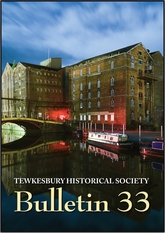
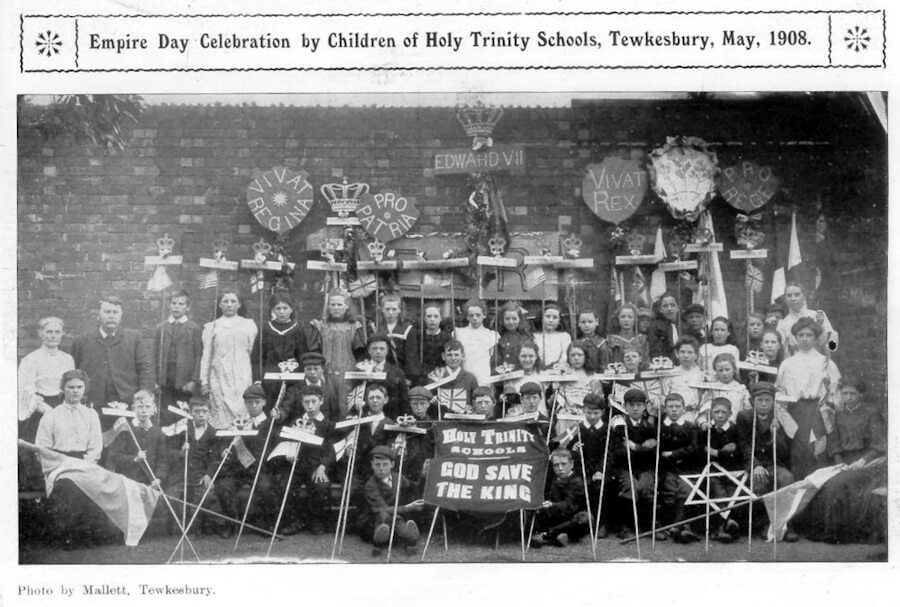
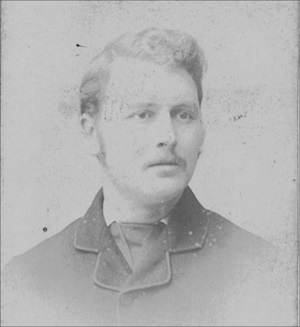
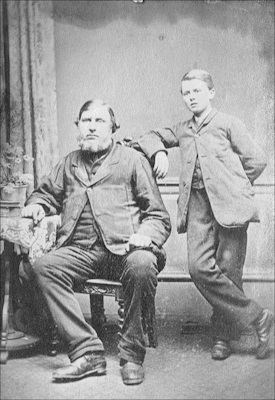
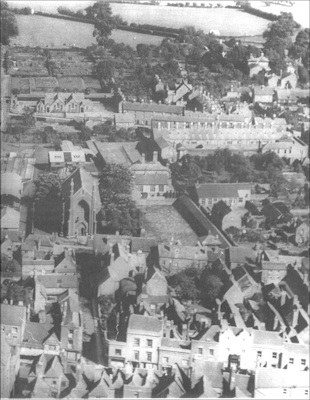
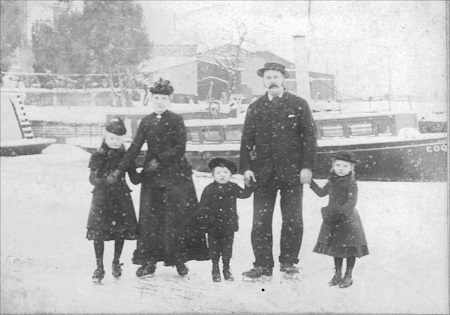
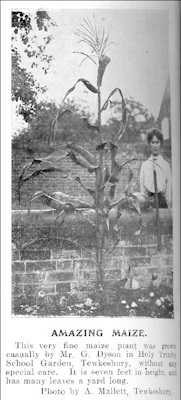
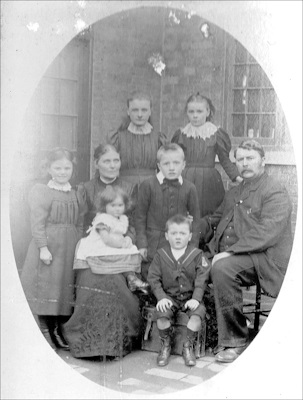
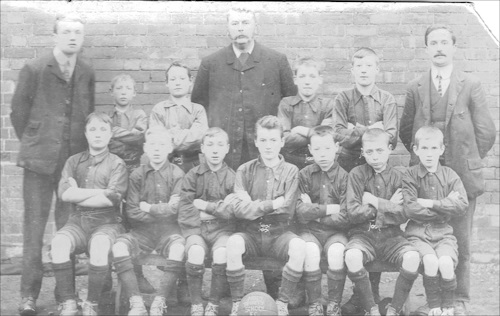
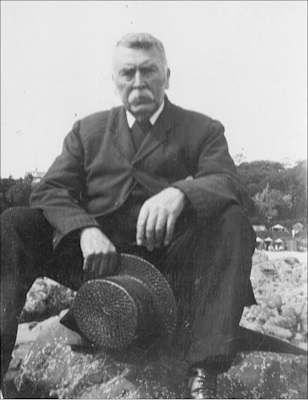
Comments